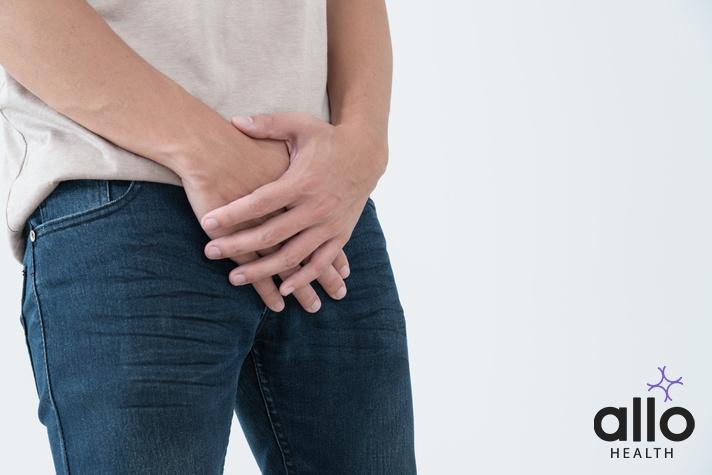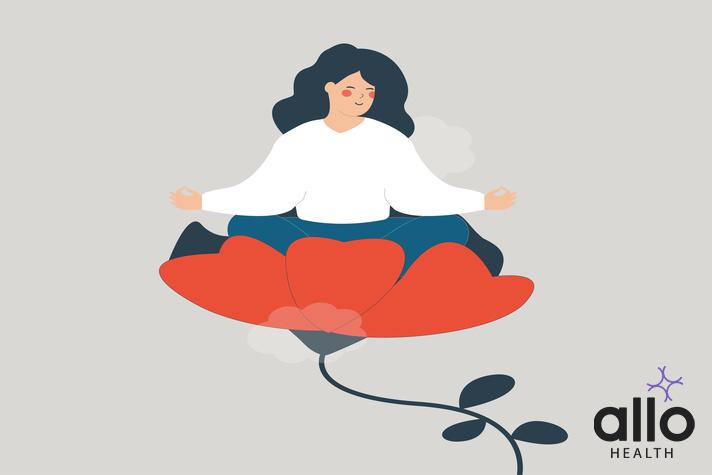At What Age Does A Woman Stop Ejaculating?

Allo Health is dedicated to personalized well-being, offering support and trusted information tailored to individual health goals. The platform emphasizes human-generated content, led by a distinguished medical team of experts, including physicians and sexual health specialists. Their commitment to credibility involves rigorous fact-checking, authoritative research, and continuous updates to ensure accurate, up-to-date information. Allo Health's unique approach goes beyond conventional platforms, providing expert-led insights and a continuous commitment to excellence, with user feedback playing a crucial role in shaping the platform's authoritative voice.

Dr. Aditi completed her undergraduate medical education at AJIMS, Mangalore, after which she worked in multi-speciality hospitals with COVID patients and in the Pain and Palliative medicine department. Driven by her experiences, she developed a keen interest in psychiatry. Dr. Aditi believes that mental health is just as, if not more important, than physical health.
Why This Was Upated?
Our experts continually monitor the health and wellness space, and we update our articles when new information became available.
Updated on 18 June, 2024
- Article was updated as part of our commitment to diversity, equity, and inclusion.

"The following blog article provides general information and insights on various topics. However, it is important to note that the information presented is not intended as professional advice in any specific field or area. The content of this blog is for general educational and informational purposes only.
Book consultation
The content should not be interpreted as endorsement, recommendation, or guarantee of any product, service, or information mentioned. Readers are solely responsible for the decisions and actions they take based on the information provided in this blog. It is essential to exercise individual judgment, critical thinking, and personal responsibility when applying or implementing any information or suggestions discussed in the blog."
Female ejaculation is a topic that has piqued curiosity and sparked discussions about sexual health and pleasure. Many people wonder about the changes that occur in a woman’s body as she ages and how it might impact her sexual experiences. One particular aspect of interest is the occurrence of female ejaculation and whether it changes over time. In this article, we will explore the age-related factors that may influence female ejaculation and shed light on when women may experience changes in this aspect of their sexual response.
Understanding Female Ejaculation
Female ejaculation refers to the release of fluid from the Skene’s glands during sexual stimulation.
-
- These glands are located around the urethra and are homologous to the male prostate gland.
- The fluid released is often clear and can vary in volume.
- Female ejaculation is not always accompanied by orgasm, but it can enhance sexual pleasure.
- The composition of the fluid includes water, prostate-specific antigen (PSA), and traces of urine.
- It’s a natural phenomenon and not a sign of any health issue.
- Understanding and accepting female ejaculation can lead to more fulfilling sexual experiences.
- Communication and mutual consent are crucial for exploring and enjoying this aspect of sexual activity.
- Research on female ejaculation is ongoing, aiming to better understand its physiological and psychological aspects.
The Science Behind Female Ejaculation

- Female ejaculation, often referred to as squirting, involves the release of fluid from the Skene’s glands, located near the urethra.
- These glands are homologous to the male prostate and can produce a fluid similar to prostatic fluid in males.
- The fluid contains a combination of substances, including prostatic-specific antigen (PSA), glucose, and fructose.
- Female ejaculation can occur through direct stimulation of the G-spot, which may lead to intense sexual pleasure and orgasm.
- The exact mechanism and purpose of female ejaculation are still debated among scientists.
- Some theories propose it serves a lubrication function, while others suggest it may play a role in fertility or sexual pleasure.
Common Misconceptions About Female Ejaculation
Female ejaculation, also known as squirting, has been the subject of many misconceptions and misunderstandings. Let’s address some of the common misconceptions surrounding female ejaculation:
- Female Ejaculation is Urine: One prevalent misconception is that female ejaculation is simply urine. While the fluid released during female ejaculation may contain trace amounts of urine due to its proximity to the urethra, but it is not primarily urine. Female ejaculate has been found to have a different chemical composition, including substances like PSA and other components not typically present in urine.
- All Women Can Ejaculate: Another misconception is that all women can ejaculate. However, research suggests that not all women experience female ejaculation. The prevalence of female ejaculation varies among individuals, and some women may never experience it, while others may experience it occasionally or regularly.
- It Only Happens with Orgasm: While female ejaculation can occur during orgasm for many women (satisfied women), it can also occur independently of orgasm. Ejaculation and orgasm are separate physiological responses, and the occurrence of female ejaculation does not necessarily indicate the presence or absence of orgasm.
- It Indicates Sexual Satisfaction: Some people mistakenly believe that female ejaculation is a measure of sexual satisfaction or the quality of a sexual experience. However, the ability to ejaculate or the absence of it is not an indicator of sexual pleasure or satisfaction. Sexual satisfaction is a complex and individual experience influenced by various factors beyond the occurrence of female ejaculation.
- It is Rare or Abnormal: Female ejaculation has often been portrayed as rare or abnormal in mainstream media and societal discussions. However, research suggests that it is a relatively common phenomenon experienced by a significant number of women. The lack of awareness and understanding surrounding female ejaculation has contributed to the perception of it as uncommon or abnormal.
- It is a Learned Behavior: Some misconceptions suggest that female ejaculation is a learned behavior or something that can be achieved through specific techniques or training. While certain sexual techniques and stimulation may enhance the likelihood of female ejaculation for some women, its occurrence is not solely dependent on learned behaviors. Factors such as individual anatomy, physiological responses, and sexual arousal play important roles.
It is crucial to dispel these misconceptions and foster a more accurate and inclusive understanding of female ejaculation. Recognizing and respecting the diversity of women’s sexual experiences is essential, and promoting open conversations and scientific research can contribute to a more informed perspective on this natural aspect of female sexuality.
How Female Ejaculation Works

Female ejaculation, also known as squirting, is a complex process that involves various physiological mechanisms. While the exact details are still the subject of ongoing research, here is an overview of how female ejaculation works based on current understanding:
- Stimulation: Female ejaculation often occurs in response to intense sexual stimulation, particularly focused on the G-spot area, which is located on the front wall of the vagina. Stimulation of the G-spot can lead to a build-up of pleasurable sensations and arousal.
- Activation of Skene’s Glands: The Skene’s glands, also known as the female prostate, are thought to play a role in female ejaculation. These glands are located around the urethra, near the G-spot area. With increased sexual arousal and stimulation, the Skene’s glands can become engorged and filled with fluid.
- Release of Fluid: When sexual arousal reaches a certain point, the engorged Skene’s glands release fluid. This fluid is typically a clear or milky liquid that may have a slightly different consistency than urine or vaginal lubrication. The release of fluid during female ejaculation can happen in varying amounts, ranging from a few drops to larger quantities.
- Contractions: Female ejaculation is often associated with rhythmic contractions of the pelvic muscles. These contractions, similar to those experienced during orgasm, help propel the fluid out of the urethra. The muscles involved in these contractions can vary among individuals.
- Composition of Fluid: The fluid released during female ejaculation has been found to contain various substances, including prostatic-specific antigen (PSA), prostate-specific acid phosphatase (PSAP), glucose, and fructose. PSA, in particular, is present in high concentrations, similar to its presence in male ejaculation. The exact composition and sources of the fluid are still being studied.
It is important to note that not all percent of women experience female ejaculation, and its occurrence can vary greatly among individuals. Additionally, the experience and amount of fluid released can differ from person to person. Factors such as individual anatomy, sexual arousal, and stimulation preferences can influence the likelihood and intensity of female ejaculation.
The Role of Hormones in Female Ejaculation
The role of hormones in female ejaculation is an area that requires further scientific investigation and understanding. While limited research has been conducted specifically on this topic, hormones are known to play a crucial role in various aspects of sexual function and reproductive physiology in both men and women. Here are some key points regarding the potential role of hormones in female ejaculation:
- Estrogen and Progesterone: Estrogen and progesterone are two primary hormones involved in regulating the menstrual cycle and reproductive processes in women. While their specific influence on female ejaculation is not yet well established, hormonal fluctuations throughout the menstrual cycle may affect sexual arousal and the sensitivity of erogenous zones, potentially influencing the likelihood or intensity of female ejaculation.
- Testosterone: Testosterone is an androgen hormone typically associated with male sexual function, but it is also present in smaller amounts in women. Testosterone plays a role in sexual desire and arousal in both genders. Some research suggests a potential link between testosterone levels in women and sexual functioning, including aspects related to female ejaculation.
- Prolactin: Prolactin is a hormone primarily known for its role in lactation and milk production in breastfeeding women. Elevated levels of prolactin have been associated with sexual dysfunction in both men and women. While no direct link has been established between prolactin and female ejaculation, it is possible that abnormal levels of prolactin could impact sexual responses and potentially affect ejaculatory processes.
- Other Hormonal Factors: Other hormones, such as oxytocin, dopamine, and serotonin, may also have indirect influences on sexual function and the physiological processes related to female ejaculation. Oxytocin, often referred to as the “love hormone,” is involved in bonding and social behaviors and could potentially contribute to sexual pleasure and responses. Dopamine and serotonin are neurotransmitters that play roles in pleasure, mood, and overall sexual functioning.
It is important to note that the understanding of the specific hormonal mechanisms involved in female ejaculation is still limited. Hormones interact with various physiological, psychological, and environmental factors that collectively influence sexual responses. Further research is needed to elucidate the specific hormonal contributions and interactions about female ejaculation.
Factors That Affect Female Ejaculation as Women Age
- Hormonal changes: As women age, hormonal fluctuations, particularly a decrease in estrogen levels during menopause, can impact the production and release of fluids (vaginal fluids) associated with female ejaculation.
- Pelvic floor strength: Weakening of the pelvic floor muscles over time can affect the intensity and frequency of female ejaculation.
- Medications: Certain medications commonly used by older women, such as hormone replacement therapy, menopausal hormone therapy, therapy for inability, or any other clinical therapy or antidepressants, may influence sexual function (may cause sexual desire disorder over some time) and ejaculation.
- Health conditions: Age-related health concerns like diabetes, hypertension, or pelvic floor disorders can affect the physiological processes involved in female ejaculation.
- Psychological factors: Emotional and psychological changes that accompany aging, such as stress, anxiety, or body image concerns, may impact sexual arousal and response, including ejaculation.
- Sexual activity frequency: Changes in libido and sexual activity levels as women age can influence the frequency and intensity of female ejaculation experiences.
Can Women Continue To Ejaculate After Menopause?
While some women may have more difficulty experiencing female ejaculation after menopause, it is still possible. Women who are experiencing vaginal dryness or changes in their hormonal balance may need to use additional lubrication or explore different sexual practices to enhance their sexual experiences. It is always important to talk to a registered health care provider about any changes in sexual function or desire or visit the nearest sexual health clinic, for optimal sexual health management.
It is important to note that female ejaculation is not the same as urine leakage or incontinence. Female ejaculation is the release of fluid from the Skene’s glands, located near the urethra. This fluid is not urine and does not have a strong odor or color. Some women may experience female ejaculation during sexual activity, regardless of their age or menopausal status. It is a natural and normal part of sexual expression for some women.
Tips for Enhancing Female Ejaculation at Any Age
- Explore your body: Take the time to explore and understand your own body and what arouses you. Experiment with different types of stimulation, such as clitoral stimulation, G-spot stimulation, or a combination of both, to enhance the potential for ejaculation.
- Pelvic floor exercises: Strengthening your pelvic floor muscles can help improve sexual function and increase the intensity of orgasms and ejaculation. It has multiple health benefits as well. Kegel exercises, which involve contracting and relaxing the pelvic floor muscles, can be beneficial. Consult a healthcare provider or a pelvic floor physical therapist for guidance.
- Engage in regular sexual activity: Regular sexual activity, whether alone or with a partner, can help maintain sexual health and function. The more you engage in sexual stimulation and arousal, the more likely you are to experience ejaculation.
- Communication with your partner: Openly communicate with your partner about your desires, fantasies, and preferences. Mutual exploration and understanding can contribute to a satisfying sexual experience and potentially enhance ejaculation.
- Relaxation and stress reduction: Stress and tension can negatively impact sexual function. Engage in relaxation techniques such as deep breathing, mindfulness, or meditation to reduce stress levels and create a more conducive environment for sexual arousal and ejaculation.
Debunking Myths About Age and Female Sexual Function
- Myth: Older women lose interest in sex.
Debunked: Many older women maintain sexual desire and satisfaction. - Myth: Aging inevitably leads to sexual dysfunction in women.
Debunked: While changes in hormone levels and physical health can impact sexual function, it’s not universal. - Myth: Older women don’t enjoy sex as much as younger women.
Debunked: Sexual satisfaction is subjective and varies greatly among individuals regardless of age. - Myth: Menopause means the end of sexual pleasure for women.
Debunked: While menopause can bring changes in sexual function, many women continue to enjoy fulfilling sex lives. - Myth: Older women are not interested in exploring their sexuality.
Debunked: Women of all ages may seek to explore and express their sexuality. - Myth: Older women are less capable of achieving orgasm.
Debunked: Orgasmic capacity can vary widely among women of all ages, and older women can still experience orgasms. - Myth: Aging diminishes attractiveness, leading to decreased sexual activity.
Debunked: Attractiveness and sexual activity are complex and multifaceted, influenced by various factors beyond age alone.
Strategies for Maintaining Sexual Health as Women Age
- Prioritize overall health: Maintain a healthy lifestyle by eating a balanced diet, exercising regularly, getting enough sleep, and managing stress. Good overall health can positively impact sexual function and satisfaction.
- Communicate with your healthcare provider: Regularly discuss your sexual health with your healthcare provider. They can provide guidance, address any concerns, and offer appropriate treatments or referrals if needed.
- Use lubrication: As women age, natural lubrication may decrease. Using a water-based lubricant during sexual activity can enhance comfort, reduce discomfort, and improve overall sexual experiences.
- Explore different sexual activities: As sexual desires and preferences may change over time, explore different types of sexual activities that bring pleasure and satisfaction. This can include intimate touching, oral sex, or using sex toys if desired.
- Maintain emotional intimacy: Emotional connection and intimacy with a partner can positively impact sexual satisfaction. Engage in activities that foster emotional closeness, such as spending quality time together, open communication, and expressing affection.
In conclusion, female ejaculation is a natural and healthy aspect of female sexuality that can occur at any age. While there may be some changes in the frequency or intensity of ejaculation as women age, there are many ways to enhance sexual experiences and promote sexual well-being. It is important to seek out accurate information and support and to prioritize self-care and communication with sexual partners.
Another important strategy for maintaining sexual health as women age is to prioritize self-exploration and masturbation. This can help to increase sexual desire and pleasure, as well as improve overall sexual function. Additionally, using lubricants and sex toys can also enhance sexual experiences and reduce discomfort or pain during sexual intercourse.
It is also important to address any emotional or psychological factors that may be impacting sexual health. This can include stress, anxiety, depression, or relationship concerns. Seeking out therapy or counseling can be helpful in addressing these concerns and improving overall sexual well-being.
Most Asked Questions
-
At what age does a woman typically stop ejaculating?
The cessation of female ejaculation is not tied to a specific age but can vary among individuals. Some women may continue to experience ejaculation throughout their lives, while others may notice changes in frequency or intensity as they age.
-
Does menopause affect female ejaculation?
Menopause, which typically occurs in women around the age of 45-55, can bring hormonal changes that may impact sexual function. While there is limited research on the specific effects of menopause on female ejaculation, hormonal fluctuations during this time may lead to changes in sexual responses and lubrication.
-
Can medical conditions or medications affect female ejaculation?
Certain medical conditions or medications may potentially influence sexual functioning, including female ejaculation. Health concerns such as hormonal imbalances, diabetes, neurological disorders, or the use of certain medications could impact the physiological processes related to ejaculation.
-
Can lifestyle factors or habits affect female ejaculation?
Lifestyle factors, such as stress, diet, exercise, and overall well-being, can influence sexual function, including ejaculation. Maintaining a healthy lifestyle, managing stress, and engaging in regular physical activity can positively impact sexual health. By participating in physical activities and adopting a more nutritious eating plan, you can enhance blood flow and enhance the well-being of your heart.
-
Is the absence of ejaculation a cause for concern?
The absence of ejaculation in women is not necessarily a cause for concern, as it can vary from person to person. It is important to remember that sexual experiences and responses differ among individuals. If you have specific concerns about ejaculation or changes in sexual function, it is recommended to consult with a healthcare provider who can provide personalized guidance and address any underlying concerns.






































